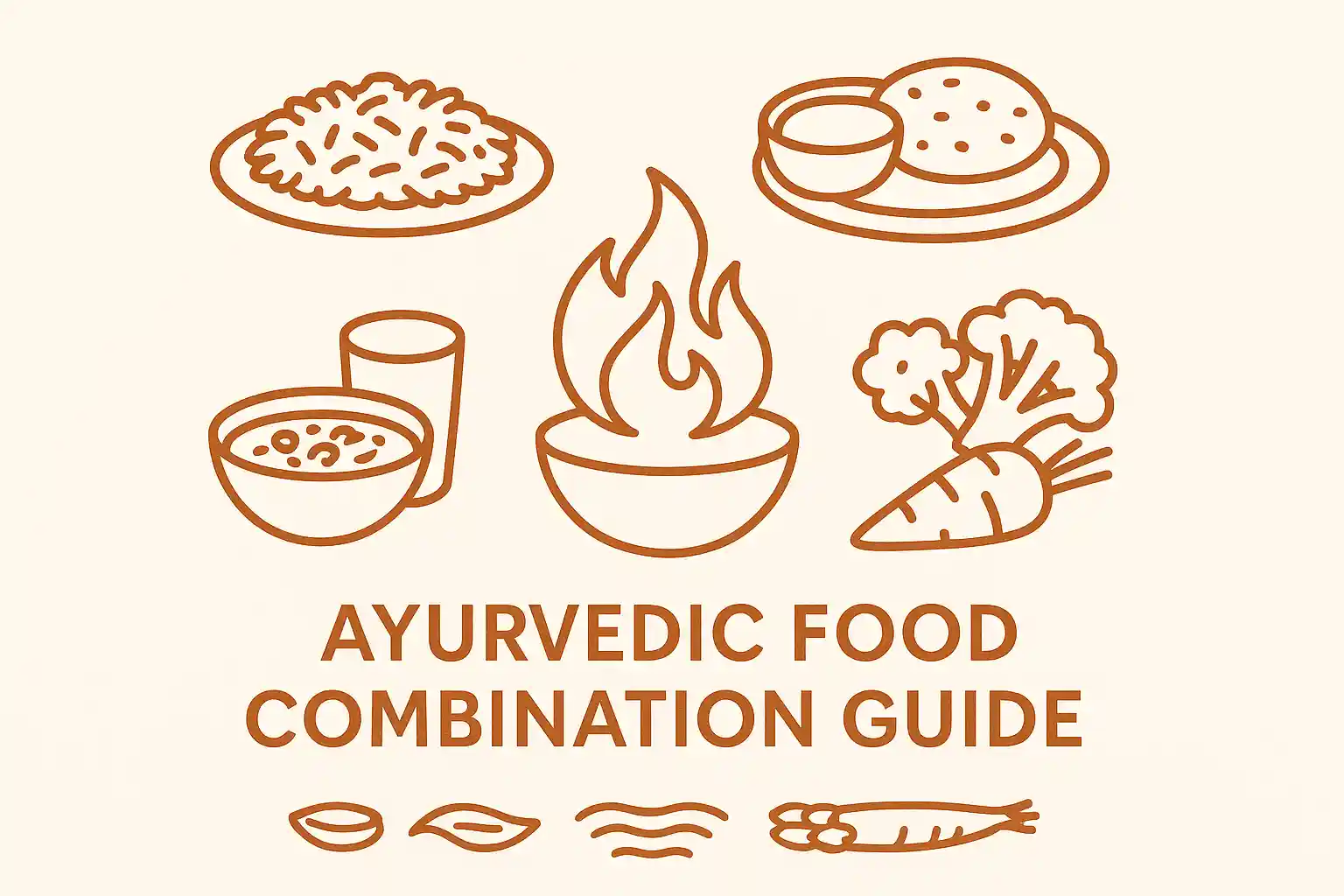Ayurveda teaches that eating with the seasons is one of the most effective ways to maintain balance and well-being. As the qualities of nature shift throughout the year, your body's needs also change — and adapting your diet helps you stay in harmony with these cycles.
Each season brings unique energetic qualities that can influence your digestion, mood, and overall health. By aligning your food choices with nature's rhythms, you can support stronger digestion, prevent seasonal imbalances, and feel your best all year round.
Seasonal eating is a fundamental principle in Ayurvedic nutrition, working alongside proper food combining and dosha awareness to create optimal wellness.
Why Eat Seasonally in Ayurveda?
According to Ayurveda, the qualities of nature — such as heat, dryness, moisture, and heaviness — fluctuate throughout the year. These qualities influence your internal balance and can either aggravate or soothe your doshas.
For example:
- Kapha tends to increase in cool, damp spring
- Pitta rises during hot, intense summer
- Vata is aggravated by the dry, cold qualities of fall and winter
Seasonal eating helps you:
- Support agni (digestive fire)
- Prevent ama (toxins)
- Balance your doshas
- Maintain resilience and vitality
By eating in tune with the seasons, you work with nature — not against it. Understanding how each season affects your individual dosha constitution and adjusting your taste preferences seasonally helps you make the most beneficial choices.
Create Your Personalized Seasonal Meal Plan
Ready to put seasonal eating into practice? Our AI-powered meal planner analyzes your dosha, current season, dietary preferences, and food inclusions/exclusions against traditional Ayurvedic principles to create truly personalized recommendations.
AI-Powered Meal Planner
Ayurvedic Diet for Spring (Kapha Season)
Spring qualities: Cool, damp, heavy → increases Kapha
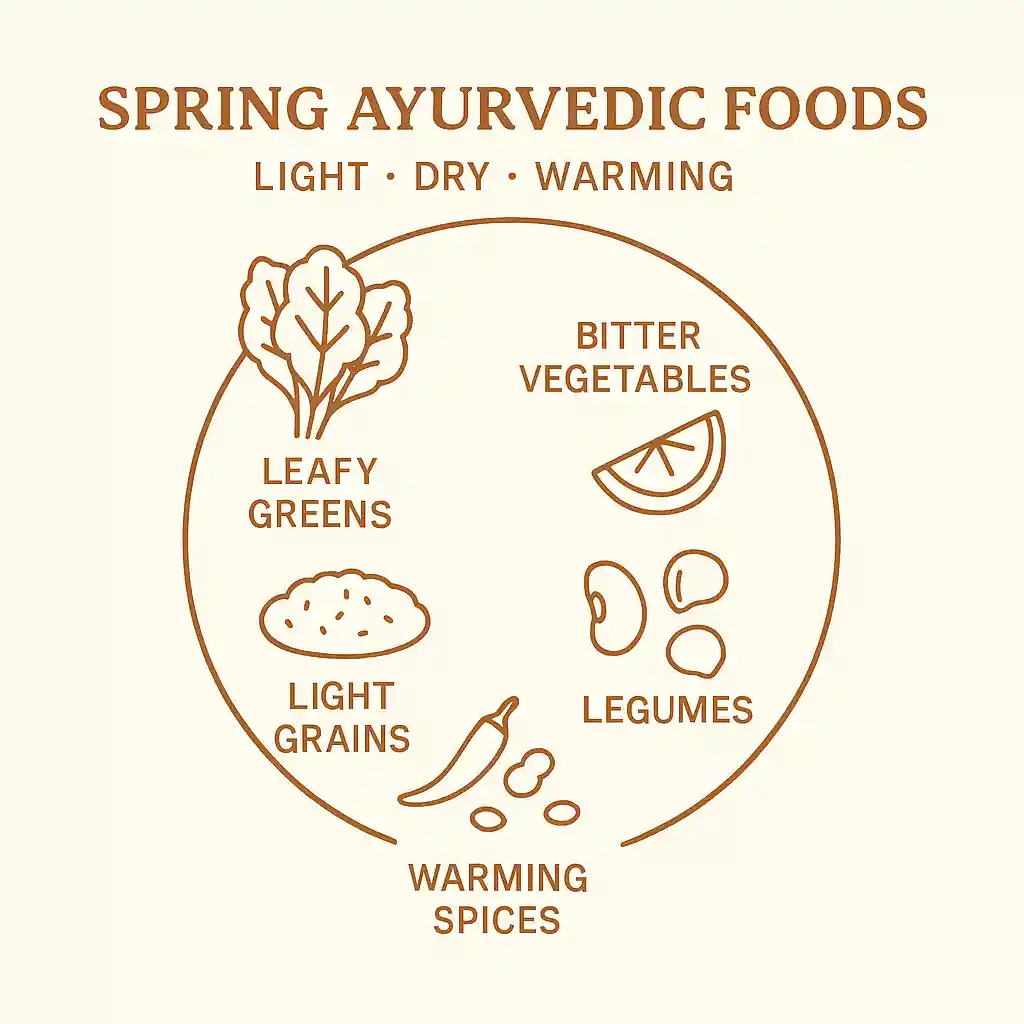
Spring foods: light, dry, and warming to balance Kapha's heavy, moist qualities
Focus:
- Light, dry, and warming foods
- Stimulate digestion and metabolism
- Reduce mucus and sluggishness
Favor:
- Leafy greens
- Bitter vegetables (dandelion, arugula)
- Spices: ginger, black pepper, turmeric
- Grains: barley, millet, buckwheat
- Legumes
Reduce:
- Dairy
- Fried and oily foods
- Excess sweets
- Heavy meats
Ayurvedic Diet for Summer (Pitta Season)
Summer qualities: Hot, light, intense → increases Pitta
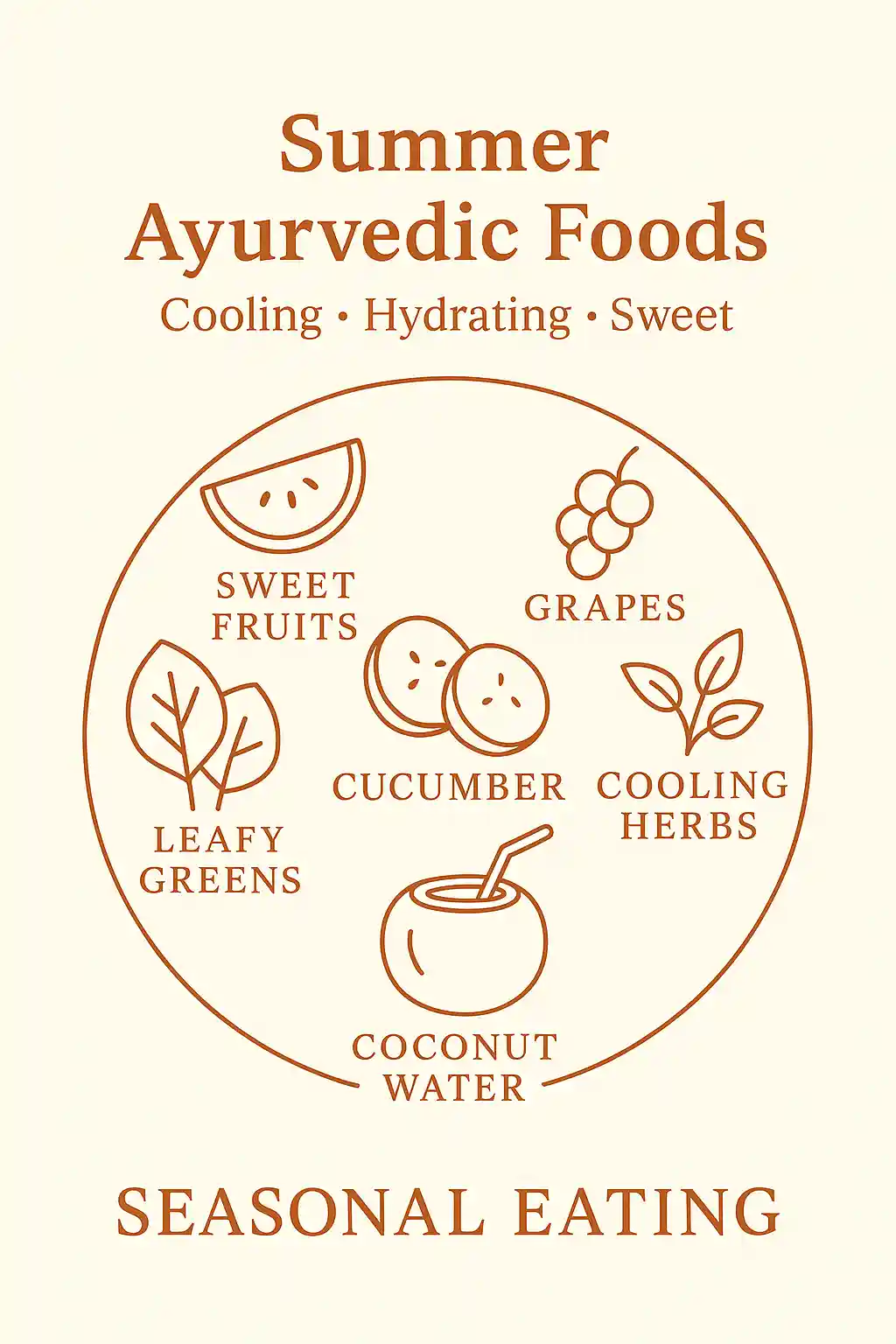
Summer foods: cooling, hydrating, and sweet to balance Pitta's hot, intense qualities
Focus:
- Cooling, hydrating, and sweet foods
- Soothe heat and inflammation
- Prevent excess acidity
Favor:
- Sweet fruits: melon, grapes, pears
- Cucumbers
- Leafy greens
- Coconut water
- Dairy (in moderation)
- Cooling spices: coriander, mint, fennel
Reduce:
- Spicy foods (chili, garlic, mustard)
- Oily and fried foods
- Alcohol
- Sour and salty flavors
Ayurvedic Diet for Fall (Vata Season)
Fall qualities: Dry, rough, cool → increases Vata
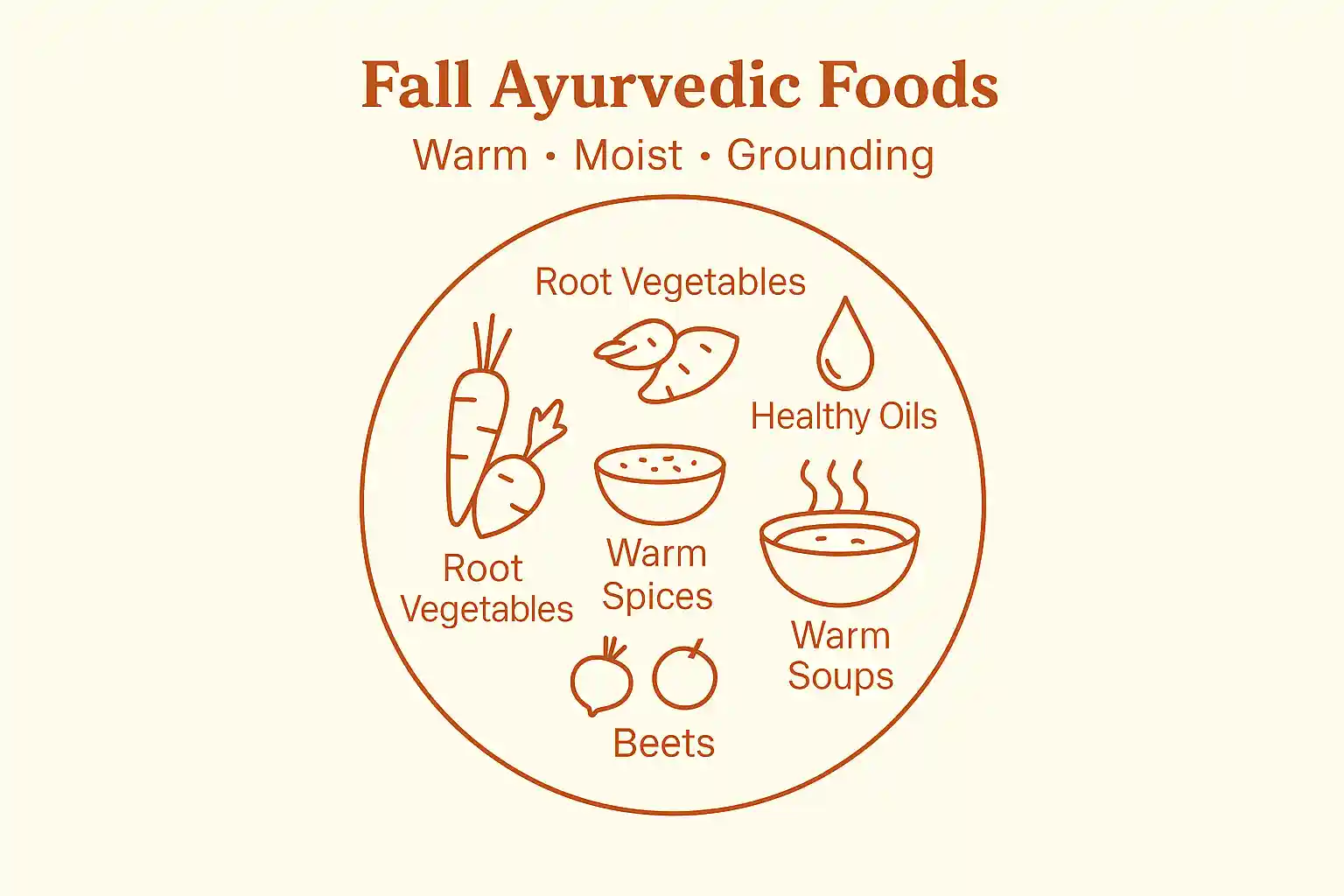
Fall foods: warm, moist, and grounding to balance Vata's dry, rough qualities
Focus:
- Warm, moist, and grounding foods
- Calm nervous system
- Support regular digestion
Favor:
- Root vegetables: sweet potatoes, carrots, beets
- Stews and soups
- Healthy oils: ghee, sesame oil
- Warm grains: oats, rice, quinoa
- Warming spices: cinnamon, nutmeg, ginger
Reduce:
- Raw vegetables
- Dry, crunchy snacks
- Cold drinks
- Beans (unless well-cooked and spiced)
Ayurvedic Diet for Winter
Winter qualities: Cold, heavy, damp → increases both Vata and Kapha
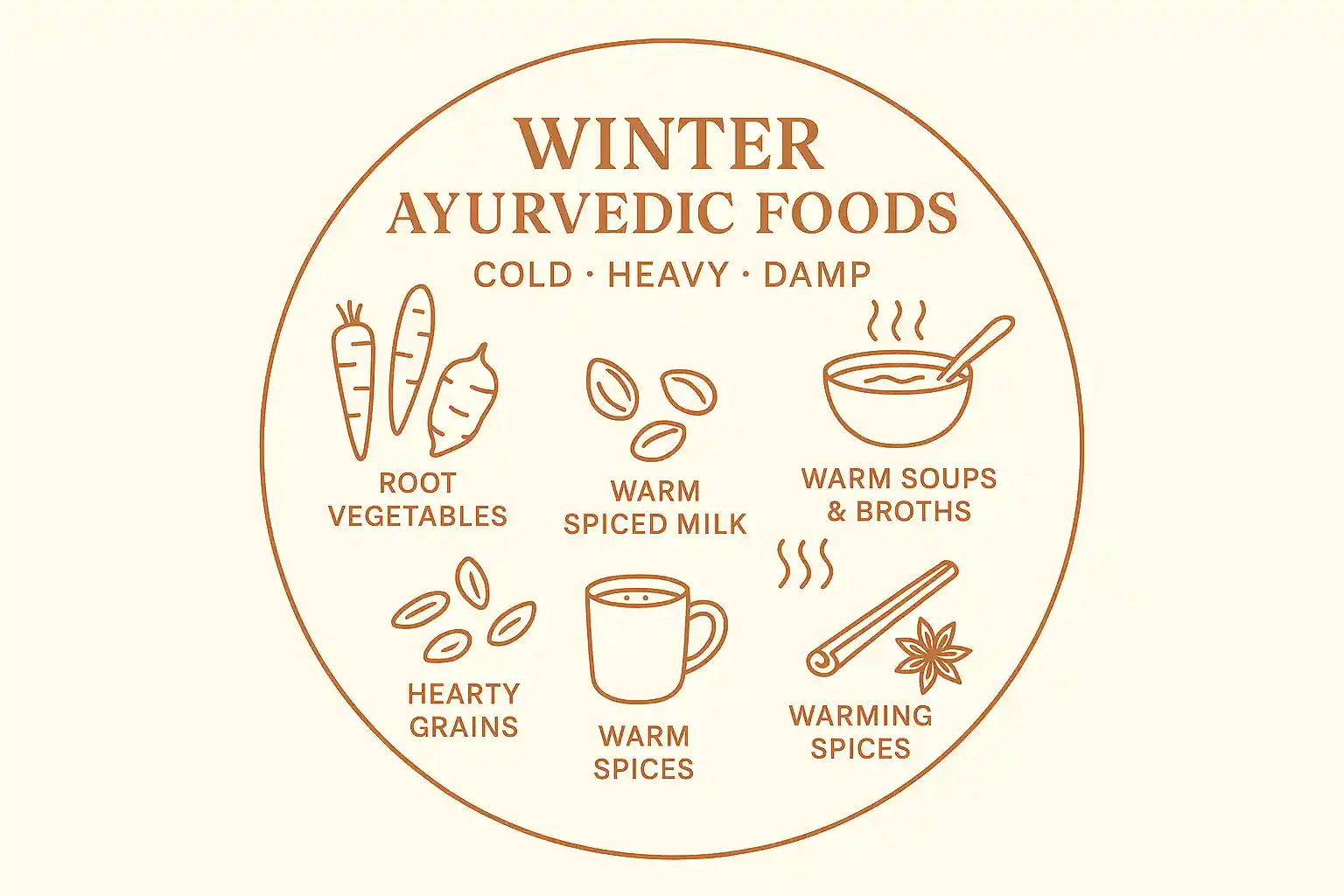
Winter foods: warm, nourishing, and oily to build strength and balance cold, heavy qualities
Focus:
- Warm, nourishing, and oily foods
- Build strength and immunity
- Balance dryness and cold
Favor:
- Root vegetables
- Soups and broths
- Nuts and seeds
- Dairy (warm milk with spices)
- Hearty grains
- Warming spices
Reduce:
- Cold foods
- Dry, raw meals
- Iced drinks
- Excess sugar
Signs You May Need to Adjust Your Seasonal Diet
If your diet isn't aligned with the current season, you may notice signs of dosha imbalance:
Spring (Kapha imbalance):
- Congestion
- Sluggishness
- Water retention
Summer (Pitta imbalance):
- Skin irritation or rashes
- Irritability
- Acid reflux
Fall (Vata imbalance):
- Dry skin
- Anxiety
- Constipation
Winter (Vata/Kapha imbalance):
- Lethargy
- Stiffness
- Mucus buildup
How to Personalize Seasonal Eating Based on Your Dosha
While seasonal guidelines apply to everyone, your unique dosha affects how you experience each season.
For example:
- Vata types are more prone to dryness in fall and winter
- Pitta types are sensitive to summer heat
- Kapha types need extra stimulation in spring
Understanding your dosha helps you fine-tune your seasonal diet for optimal balance. Seasonal eating also works best when combined with proper food combining principles to support digestion year-round.
Final Thoughts
Seasonal eating is a core Ayurvedic practice for maintaining balance and vitality throughout the year. By aligning your diet with the rhythms of nature — and listening to your body's signals — you can support digestion, immunity, and overall well-being.
Start with simple changes. Notice how your body responds, and adapt your meals to bring more harmony into each season of life.
Frequently Asked Questions
Common questions about seasonal Ayurvedic eating principles
Congratulations! You've Completed Core Knowledge
You've mastered the four foundations of Ayurvedic eating. Now it's time to put your knowledge into practice!
Apply your knowledge with our personalized toolsReady to take the next step?
Related Articles

What Is Agni? A Beginner's Guide to Ayurvedic Digestive Fire
Discover Agni, the vital digestive fire in Ayurveda that transforms food into energy and health. Learn the 4 types of Agni, signs of imbalance, and practical ways to strengthen your digestive fire naturally.
12 min read
What Is Ayurvedic Eating? A Complete Guide to Ancient Nutrition Wisdom
Discover the ancient holistic approach to food that goes beyond calories and nutrients. Learn how Ayurvedic eating aligns with your body, mind, and constitution for optimal health and wellness.
8 min read
